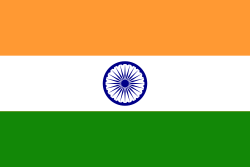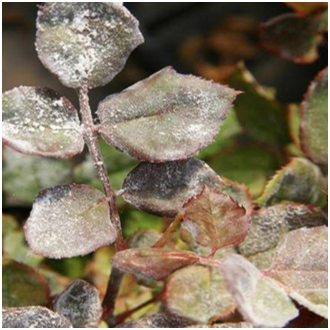
Host Plant :: Rose
Powdery mildew:
Sphaerotheca pannosa
Powdery mildew is one of the most common diseases that affect roses. Powdery mildew can cause significant damage to roses, reducing the quality and quantity of the flowers produced. In severe cases, the disease can lead to premature defoliation, reduced plant growth and even plant death. Powdery mildew thrives in cool, humid conditions with moderate temperatures between 16-24°C. High humidity levels and low light intensities also favour the development of the disease.
Symptoms:
- The symptom appears as grayish-white powdery substance on the surfaces of young leaves, shoots and buds.
- Infected leaves may be distorted, and some leaf drop may occur.
- Flower buds may fail to open, and those that do may produce poor-quality flowers.
- It can occur almost anytime during the growing season when temperatures are mild (70 to 80 °F), and the relative humidity is high at night and low during the day.
- It is most severe in shady areas and during cooler periods
Management:
- Collection and burning of fallen leaves.
- Spray with Wettable sulphur 0.3% (or) Carbendazim 0.1% 2-3 sprays at 15 days interval is effective.
- Sulphur dust at 25 kg/ha.
- Use of Sulphur at higher temperature conditions will be phytotoxic.
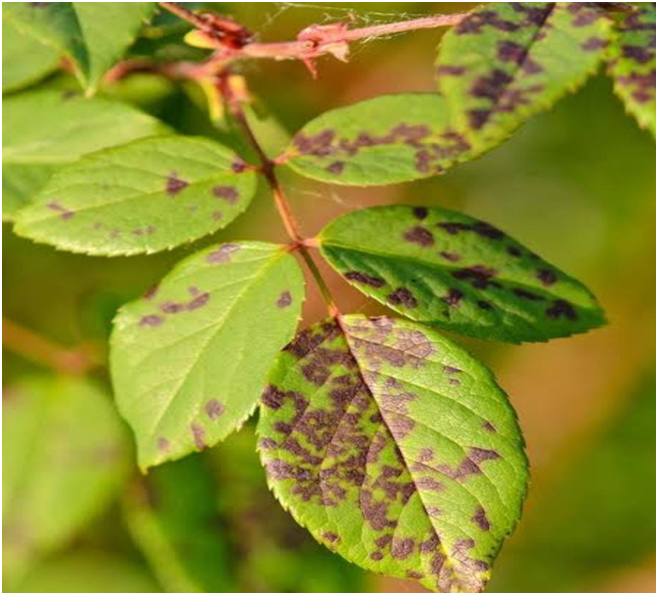
Downy mildew
Peronospora sparsa
Rose downy mildew disease is caused by Peronospora sparsa, an obligate biotrophic oomycete. This disease is one of the most destructive diseases of rose plants and attacks all types of roses in greenhouse, nursery and landscape settings. Although rose downy mildew does not infect other ornamentals, P.
Symptoms:
- Early symptoms include yellow spots or lesions on the upper area of the leaf.
- The spots or lesions may turn purple, red or black overtime and will boarder along the veins of the leaf.
- Downy mildew can easily be confused with black spot; however, lesions tend to begin near or at the bottom of the infected plant whereas in downy mildew the infection will begin to show symptoms around the top part of the plant. Defoliation may occur before the lesions become visible on the leaves.
- Lesions may also become necrotic in dry conditions .
Management:
- spray of Fubol Gold (metalaxyl-M + mancozeb),
- Aliette 80WG or Amistar every 7 days reduced the leaf area affected by downy mildew by around 60%.
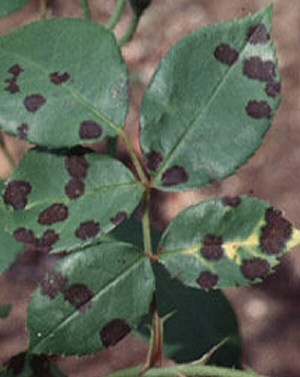
Black spot
Diplocarpon rosae
A common disease of roses called black spot is caused by the fungus Diplocarpon rosae. This fungus readily attacks young expanding leaves and young canes.
Symptoms:
- Black spot (blackspot) is the most important fungal disease of roses worldwide.
- The initial symptoms start as feathery-edged, black spots on lower leaves.
- As these spots enlarge, the leaves turn yellow and drop off. The disease continues up the stems until the entire plant becomes defoliated.
- Stem lesions are less obvious but start as dark, irregular blotches that eventually become blistered.
- Stem lesions are the most important source of fungal spores for initiation of the infection cycle next season.
- The disease is caused by the fungal pathogen Diplocarpon rosae.
- Leaves are most susceptible when young and must remain moist overnight before infection can occur.
- The disease can be spread by rain, dew, irrigation, people, insects, and transport of infected plants.
Management:
- Removal of fallen leaves and pruning infected canes will dramatically slow initial spring infections.
- Good air circulation will reduce the incidence of black spot by promoting faster drying of leaf surfaces.
- Restrict irrigation during cloudy, humid weather.
- Most people will need to use labeled fungicide sprays every 7-14 days as the first leaves emerge in the spring through the fall for adequate control of this disease.
- It is best to spray before a rain event to protect the leaves and to alternate types of fungicides. Removal of fallen leaves and pruning infected canes will dramatically slow initial spring infections.
- Good air circulation will reduce the incidence of black spot by promoting faster drying of leaf surfaces.
- Restrict irrigation during cloudy, humid weather.
- Most people will need to use labeled fungicide sprays every 7-14 days as the first leaves emerge in the spring through the fall for adequate control of this disease.
- It is best to spray before a rain event to protect the leaves and to alternate types of fungicides.
Insect Pests of Roses
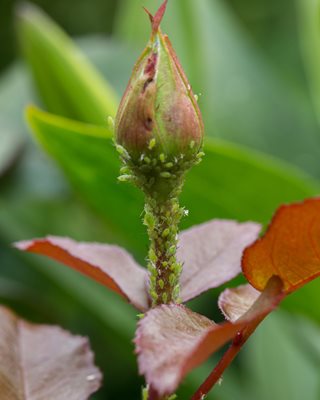
Aphids (about 1/8 inch): Aphids are small, slow-moving, soft-bodied insects with piercing sucking mouthparts. Several species occur on roses, but the rose aphid is one of the most common. Female aphids give birth to live aphid nymphs, which are able to become mothers themselves within a week to 10 days. In addition most aphids are females, which are able to reproduce without mating. Consequently, aphids can quickly reach high populations.
Damage: Aphids cause damage by sucking plant sap. Because they often concentrate on tender growing tissue, like terminals and flower buds, they can cause distorted or stunted growth. These insects excrete a sticky substance known as honeydew, which contains large amounts of undigested sugars. Honeydew accumulates on leaves and supports a black fungal growth known as sooty mold. Sooty mold fungi are not pathogenic, but accumulations of sooty mold are unsightly and can interfere with photosynthesis.
Management: Fortunately, there are many naturally occurring predators, parasites, and diseases that help keep aphid populations in check. Avoid unnecessary insecticide use, which can trigger aphid outbreaks by destroying these natural control agents. When heavy accumulations of aphids are detected on terminals or buds, you can use a forceful spray of water to physically wash them from the plant. Avoid excessive amounts of nitrogen fertilizer as this encourages aphids.
Control: Acephate, imidacloprid, malathion, disulfoton, insecticidal soap, pyrethrins + canola oil. Soil-applied systemic insecticides like imidacloprid or disulfoton will help prevent aphids. When foliar treatments are needed, products like insecticidal soap, neem oil, or canola oil are least disruptive to biological control. For heavy infestations that require immediate control use foliar sprays containing acephate, imidacloprid, or malathion.
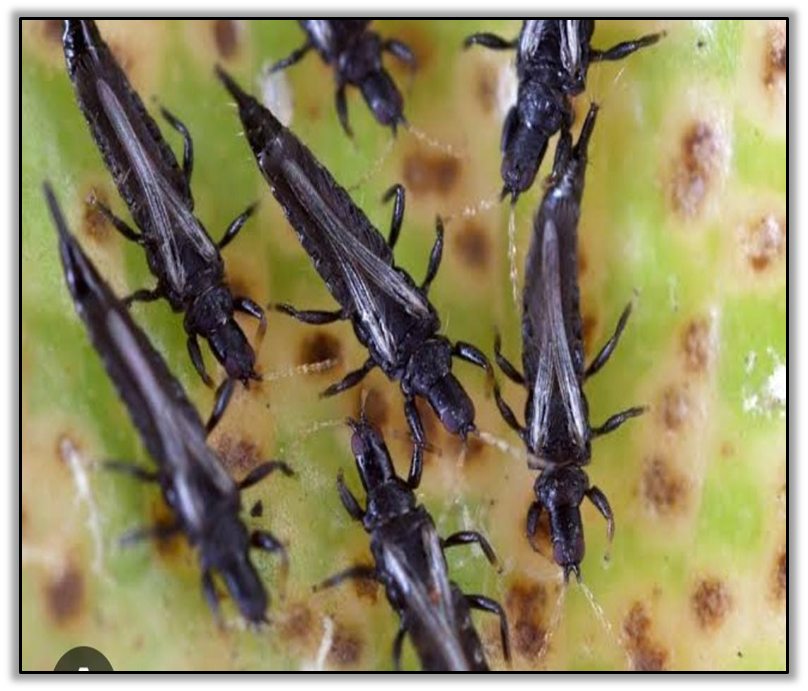
Thrips: (about 1/16 inch) Thrips are some of the most important insect pests of roses. There are several species, with flower thrips and western flower thrips being two of the most common. Thrips are tiny, elongate insects that are no more than 1/16th of an inch long when fully mature. Most adults have fringed wings that they carry folded lengthwise over the body, but these are only evident when viewed through magnification. Immature thrips are usually light yellow to lemon colored and are spindle-shaped.
Damage: In roses, thrips can cause damage mainly by feeding on flowers. Their injury reduces the aesthetic value of the blooms of roses and heavy infestations can prevent buds from opening. Thrips feed by punching plant cells with their needle-like mandible and sucking up the resulting plant juices. This results in silvery or bleached damaged areas, on flower petals, that eventually turn brown. Because feeding is often concentrated on young, actively growing tissue, petals and leaves are often crinkled or distorted as they continue to expand after being damaged.
Management: Because thrips are carried by prevailing winds, strategically placed windbreaks, either structural or plant hedges, can help protect rose plantings from the heavy populations of migrating thrips that often occur in late spring. These won’t intercept all of the wind blown thrips, but where feasible, such windbreaks can help reduce this heavy thrips pressure.
Control: acephate, malathion, imidacloprid, cyfluthrin, cyhalothrin, permethrin, spinosad, insecticidal soap: Soil drench treatments of imidacloprid will aid in control of foliage feeding thrips, but thrips feeding in flowers are more difficult to control. During late spring to early summer, large numbers of thrips migrate from maturing weeds and other hosts. Weekly sprays may be necessary to minimize damage during such periods of heavy migration. Thrips also breed directly on roses and these ‘local’ populations can require control throughout they year. Spinosad is one of the more effective foliar treatments for thrips control.
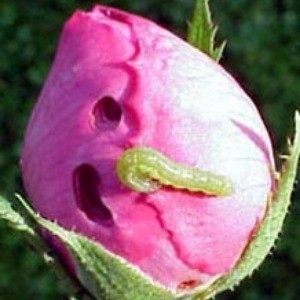
Bud Borer:
Management
|
